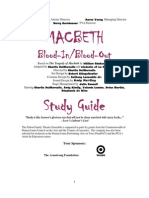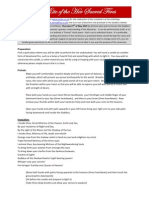Film Analysis Terms
Film Analysis Terms
Uploaded by
floramatherCopyright:
Available Formats
Film Analysis Terms
Film Analysis Terms
Uploaded by
floramatherOriginal Description:
Copyright
Available Formats
Share this document
Did you find this document useful?
Is this content inappropriate?
Copyright:
Available Formats
Film Analysis Terms
Film Analysis Terms
Uploaded by
floramatherCopyright:
Available Formats
Terms used for Film Analysis
What is film analysis?
A film is like any other form of literary text. It is a medium for telling stories just like novels, poems, and short stories are. To ensure that your essays reflect the fact that you are writing specifically about film, your essay needs to incorporate analysis of the structure of the film as well as the characters, theme and setting.
Terms
Film Techniques There is a specific language that you need to be familiar with in order to analyse film and show your understanding of how ideas are communicated. These terms are film techniques Mise en scene The elements that comprise what is happening on the screen. Analysing mise en scene is important in understanding specifically how visual elements are used to communicate ideas. !uestions that ask you to discuss production techniques or key scene"s# will require a discussion of mise en scene. $ou need to be as specific as possible. The way in which the camera is used to tell a story. %onsider camera angles, proximity of camera to subject, movement of the camera in relation to the subject, movement of the subject in relation to the camera. Think about what is in the frame & how is space used' (ow is your perspective of what is happening manipulated by camera work' %inematography is important in understanding characterisation and setting in particular. Again, discussion of this needs to be as specific as possible. This is when an object stands for an idea. If this symbol is recurring, it becomes a motif. )ymbolism is used to convey themes and, to some extent, characterisation. This is when a person stands for an idea. This is similar to the idea of stereotyping & where an individual is considered to stand for general characteristics. A representation is often composed of repeated elements. The more we see these elements repeated, the more the representation will appear natural or normal. %haracters in films can often function as representations. This means that they are not always designed to be *true to life+ personalities but representations of certain ideals, or stereotypes. ,xamples of representative character types include *the unemployed+, *the loving wife+, *no hoper student+ or *politician+. )ometime characters embody particular ideas, for example, *hope+, *activism+, *jealousy+.
Cinematography
Symbolism Representation
Characterisation
The way in which characters are portrayed on the screen. ,lements that contribute to this are soundtrack, dialogue, costuming, cinematography and mise en scene.
Narrative These narrative terms relate to the structure of the story - plot. E position ,xposition refers to the beginning of the narrative. The function of the exposition is to draw the members of the audience into the narrative, allow them to make sense of what is happening, generate appropriate expectations and encourage them to keep watching. %reators of visual narratives do this by indicating early in the narrative The background information The nature of the main characters The atmosphere The conflict or problem with which the narrative deals
Conflict
.lots often revolve around conflict. This is what generate the suspense and interest for the audience. %onflicts can be Interpersonal & person versus person /atural & person versus nature "such as surviving in a storm at sea# Internal & .erson versus self Ideological & 0ne person+s values or ideas against another+s or those of a social grouping. A useful way of analysing conflicts in a narrative is in terms of oppositions. %reators of texts often construct characters with sets of oppositions, "binaries#. This heightens the sense of difference, contrast and conflict between them. 1or example, the story of 2oldilocks and the Three 3ears. The bears 4ictims of a senseless crime %aring family (ealth conscious porridge eaters )trong moral values %omfortable, family home 6eft to pick up the pieces !ol"iloc#s Thief 5enegade youth with no thought for others )coffer of stolen spoils )elfish hedonist (omeless vagrant 5uns away, carelessly laughing
0f course, much of the meaning that we gain is based on representation and interpretation$ The bears 1erocious carnivores 1ilthy capitalist materialists 8iddle class heterosexual norm %omplacent and obese !ol"iloc#s )mall, innocent child 7estitute 8arginalised minority group 1rail, malnourished
4engeance seekers Resolution
1reedom fighter, liberated by the shackles of society
5esolution refers to the ending of the narrative. The conflict or resolution is often resolved, usually in a way that makes sense to the audience. If the resolution is unfitting to the conflict, audiences can feel frustrated or disappointed. Thinking about the resolution is important because the resolution reflects particular attitudes, values and beliefs. %onsider why we often expect or desire happy endings to narratives and what this *happy ending+ entails.
You might also like
- Short Story Elements HandoutDocument3 pagesShort Story Elements Handoutapi-262266786100% (1)
- Cartoon AnalysisDocument3 pagesCartoon Analysisfloramather100% (1)
- Narrative Writing BookletDocument15 pagesNarrative Writing Bookletmonique walker100% (1)
- Graphic Novel Conventions and Visual Language TerminologyDocument6 pagesGraphic Novel Conventions and Visual Language Terminologyfloramather100% (1)
- Narrative Conventions and Language Devices For English StudentsDocument18 pagesNarrative Conventions and Language Devices For English StudentsNAKIPEHKSNo ratings yet
- 1 LittermspptDocument49 pages1 LittermspptMohd Witri Hafiz WitriNo ratings yet
- 2 The Seven Key Elements of FictionDocument21 pages2 The Seven Key Elements of Fictionrichard allen fulladoNo ratings yet
- Elements of Literay GenreDocument9 pagesElements of Literay GenreCacai Monteron PeraltaNo ratings yet
- Literary Devices Elements TechniquesDocument38 pagesLiterary Devices Elements Techniquessenior high100% (3)
- Character: The Seven Key Elements of FictionDocument5 pagesCharacter: The Seven Key Elements of FictionKlint Van100% (1)
- Narrative Structure Narrative Structure, A: Literary Element Narrative Plot SettingDocument8 pagesNarrative Structure Narrative Structure, A: Literary Element Narrative Plot Settingjohn christopherNo ratings yet
- English POINTERS Q1Document16 pagesEnglish POINTERS Q1Suarez, MariahNo ratings yet
- Scriptwriting: Danish MaqsoodDocument21 pagesScriptwriting: Danish MaqsoodDanish MaqsoodNo ratings yet
- Types of Characters in FictionDocument2 pagesTypes of Characters in FictionAnna Rumyantzeva0% (1)
- Elements of LiteratureDocument8 pagesElements of LiteratureLouie Cisneros del MundoNo ratings yet
- Introduction To The Subjectliterary DevicesDocument41 pagesIntroduction To The Subjectliterary DevicesKath Tan AlcantaraNo ratings yet
- CNF The Literary ElementsDocument5 pagesCNF The Literary ElementsAio MinNo ratings yet
- Identifying The Writer's Purpose: Module in English 10Document13 pagesIdentifying The Writer's Purpose: Module in English 10Airah Ballesteros100% (1)
- Elements of AutobiographyDocument2 pagesElements of AutobiographyDavid PenningNo ratings yet
- CNF q3 Lesson 6 Elements of CNF Part 2Document45 pagesCNF q3 Lesson 6 Elements of CNF Part 2Jechelle V. BanzuelaNo ratings yet
- Theories of Story and Storytelling: Cinematic Storytellers. To Be Most Verbally Accurate, We Might Say That MovieDocument7 pagesTheories of Story and Storytelling: Cinematic Storytellers. To Be Most Verbally Accurate, We Might Say That MovieBryan O.No ratings yet
- 2nd Quarter LESSON 2Document7 pages2nd Quarter LESSON 2Salve BayaniNo ratings yet
- Major Genres of LiteratureDocument121 pagesMajor Genres of LiteratureAlyanna JovidoNo ratings yet
- Grade 12 Creative Non FictionDocument6 pagesGrade 12 Creative Non FictionbetingleaNo ratings yet
- Drama Strand - Progression Through Freeze Frame ActivityDocument8 pagesDrama Strand - Progression Through Freeze Frame ActivitySyafiq IzharNo ratings yet
- Elements of FictionDocument37 pagesElements of FictionJie em AgutayaNo ratings yet
- Elements of A StoryDocument30 pagesElements of A Storybenmessaoudhoussam11No ratings yet
- Lesson 6 - The Nature and Elements of FictionDocument23 pagesLesson 6 - The Nature and Elements of Fictionmikasalesdimapilis1724No ratings yet
- Lesson 1 NarrationDocument39 pagesLesson 1 NarrationPagatpatan James Allen QuibingcoNo ratings yet
- The Lottery: Shirley JacksonDocument20 pagesThe Lottery: Shirley JacksonShekinah FuentesNo ratings yet
- Basics of Animation NotesDocument53 pagesBasics of Animation Notespriyal jainNo ratings yet
- Basics of Animation NotesDocument53 pagesBasics of Animation Notespriyal jainNo ratings yet
- Narrative ElementsDocument4 pagesNarrative Elementsbhumibajaj496No ratings yet
- SurphilDocument58 pagesSurphilJan Kate Valledor LambiquitNo ratings yet
- Lesson Plan in English 10Document9 pagesLesson Plan in English 10Mary Jane CerenaNo ratings yet
- Narrative Writing: Compiled By: Mr. M. EwanDocument35 pagesNarrative Writing: Compiled By: Mr. M. EwanBab100% (1)
- Fiction in EnglishDocument61 pagesFiction in EnglishFox GamingNo ratings yet
- Creative M1Document14 pagesCreative M1Jacob SalazarNo ratings yet
- Elements of Creative NonfictionDocument50 pagesElements of Creative NonfictionKen Donal100% (1)
- Ash - Narrative AssignmentDocument7 pagesAsh - Narrative AssignmentAshAngeLNo ratings yet
- CW NotesDocument20 pagesCW NotesPriyanka TatpatiNo ratings yet
- Narrative ClassmateDocument5 pagesNarrative ClassmateIrish AlonzoNo ratings yet
- Story and Poetry ElementsDocument72 pagesStory and Poetry Elementsdgod3600No ratings yet
- Understanding Major Literary GenresDocument126 pagesUnderstanding Major Literary GenresSourTasteNo ratings yet
- What Is Creative NonfictionDocument4 pagesWhat Is Creative NonfictionAnnekaVidalTabotaboNo ratings yet
- Elements of Fiction: Characters: Quarter I - Week 5Document43 pagesElements of Fiction: Characters: Quarter I - Week 5angeline marie limbaga100% (1)
- UNIT-2Document59 pagesUNIT-2denissemarizpNo ratings yet
- What Is Literature?Document13 pagesWhat Is Literature?Abdullah AdnanNo ratings yet
- Qwertyuiop - Form 4Document53 pagesQwertyuiop - Form 4Ida HashimNo ratings yet
- Quarter 3 - Module 3: Literary Approaches: EnglishDocument7 pagesQuarter 3 - Module 3: Literary Approaches: Englishjessemar wao100% (1)
- Creative FictionDocument8 pagesCreative Fictionjeromegarcialandig20No ratings yet
- Lecture 1 2 3 and 4 Hijack StoriesDocument40 pagesLecture 1 2 3 and 4 Hijack Storiesmaswanganyemasingita17No ratings yet
- Literary Elements: Character Plot Point of View (P.O.V.) Setting Style, Tone, and Irony Theme SymbolismDocument7 pagesLiterary Elements: Character Plot Point of View (P.O.V.) Setting Style, Tone, and Irony Theme Symbolismr_castro-1No ratings yet
- The 8 Methods of Characterization Powerpoint 1216839817868468 9Document20 pagesThe 8 Methods of Characterization Powerpoint 1216839817868468 9Anissa GeddesNo ratings yet
- Creative Nonfiction WorksheetDocument6 pagesCreative Nonfiction WorksheetGershom Perez AcaboNo ratings yet
- Hand Out For 1st QuarterDocument2 pagesHand Out For 1st QuarterTam FerrolNo ratings yet
- The 8 Methods of Charsdserpoint 1216839817868468 9Document20 pagesThe 8 Methods of Charsdserpoint 1216839817868468 9AdjjdsdsZxsxsNo ratings yet
- CNF2023Document46 pagesCNF2023scwarne95No ratings yet
- Author Helpful Writing Tips - Empowering Authors Collection Book ThreeFrom EverandAuthor Helpful Writing Tips - Empowering Authors Collection Book ThreeNo ratings yet
- Aristotelian-inspired Screenwriting: A Simple Guide to Complex StorytellingFrom EverandAristotelian-inspired Screenwriting: A Simple Guide to Complex StorytellingRating: 5 out of 5 stars5/5 (2)
- Plot Perfect: How to Build Unforgettable Stories Scene by SceneFrom EverandPlot Perfect: How to Build Unforgettable Stories Scene by SceneRating: 4 out of 5 stars4/5 (10)
- Glossary of Literary TermsDocument13 pagesGlossary of Literary TermsfloramatherNo ratings yet
- The Leaderless DiscussionDocument4 pagesThe Leaderless DiscussionfloramatherNo ratings yet
- Visual Text AnalysisDocument2 pagesVisual Text Analysisfloramather100% (1)
- Student SurveyDocument6 pagesStudent SurveyfloramatherNo ratings yet
- Film GenreDocument1 pageFilm GenrefloramatherNo ratings yet
- Outline TemplateDocument2 pagesOutline TemplatefloramatherNo ratings yet
- Individual Oral Commentary Marking CriteriaDocument2 pagesIndividual Oral Commentary Marking CriteriafloramatherNo ratings yet
- Wag The Dog AnalysisDocument25 pagesWag The Dog Analysisfloramather50% (2)
- Cinematography and Mise en SceneDocument12 pagesCinematography and Mise en ScenefloramatherNo ratings yet
- Character DevelopmentDocument2 pagesCharacter DevelopmentfloramatherNo ratings yet
- Symbolism and RepresentationDocument1 pageSymbolism and RepresentationfloramatherNo ratings yet
- President Obama CommentsDocument4 pagesPresident Obama CommentsfloramatherNo ratings yet
- Effective Teacher Leaders - Who Are They and How Do They WorkDocument3 pagesEffective Teacher Leaders - Who Are They and How Do They WorkfloramatherNo ratings yet
- Literary Works Often Show Men and Women Struggling To Resolve Problems and Not Succeeding Very Well.Document3 pagesLiterary Works Often Show Men and Women Struggling To Resolve Problems and Not Succeeding Very Well.floramather50% (2)
- FOA Reflection Form-1Document2 pagesFOA Reflection Form-1floramatherNo ratings yet
- Language and Taboo Further Oral ActivityDocument2 pagesLanguage and Taboo Further Oral Activityfloramather100% (2)
- Written Task 2 Based On All Quiet On The Western Front PDFDocument5 pagesWritten Task 2 Based On All Quiet On The Western Front PDFfloramatherNo ratings yet
- Taboo in ImagesDocument14 pagesTaboo in Imagesfloramather100% (3)
- Exemplar Based On The Things They Carried PDFDocument3 pagesExemplar Based On The Things They Carried PDFfloramatherNo ratings yet
- Curtius Rufus The Macedonian Mutiny at ODocument50 pagesCurtius Rufus The Macedonian Mutiny at OBranko NikolicNo ratings yet
- Stance AdverbsDocument36 pagesStance Adverbsremovable100% (3)
- Autobiography & BiographyDocument28 pagesAutobiography & Biographyam_jaluNo ratings yet
- Tantra Philosophy of Ananda Marga: StudentDocument20 pagesTantra Philosophy of Ananda Marga: StudentshubhanyNo ratings yet
- Elt Congress HandbookDocument19 pagesElt Congress Handbookapi-319584593100% (1)
- 141 Lecture Notes 23Document61 pages141 Lecture Notes 23Ada AdaköyNo ratings yet
- 8th Grade Worksheet BundleDocument29 pages8th Grade Worksheet BundleLisa WardNo ratings yet
- Macbeth Study GuideDocument13 pagesMacbeth Study GuideXabier Coscojuela Ojeda100% (2)
- A Stylo-Pragmatics Analysis of Wale Okediran's Tenants of The HouseDocument60 pagesA Stylo-Pragmatics Analysis of Wale Okediran's Tenants of The HouseDimeji Victor100% (1)
- Excerpt (Ch. 2) - The Sword of Summer by Rick RiordanDocument4 pagesExcerpt (Ch. 2) - The Sword of Summer by Rick Riordanforeveryoungadult33% (3)
- Sacred FiresDocument2 pagesSacred FiresGraham Harris100% (1)
- A Valediction Forbidding MourningDocument1 pageA Valediction Forbidding Mourningvigneshvms0% (1)
- Great Essays, 2nd EditionDocument42 pagesGreat Essays, 2nd EditionHoda ElhadaryNo ratings yet
- Afro-Asian LiteratureDocument64 pagesAfro-Asian LiteratureShannara Ellise100% (2)
- Cultural Achievements of SungasDocument3 pagesCultural Achievements of SungasJitendra Meena RonNo ratings yet
- Hamilton-Arch of Hesiodic Poetry 3Document47 pagesHamilton-Arch of Hesiodic Poetry 3Trad AnonNo ratings yet
- December 1989 and The Concept of RevolutDocument20 pagesDecember 1989 and The Concept of RevoluttaraselbulbaNo ratings yet
- Pride and PrejudiceDocument8 pagesPride and PrejudiceVieru EcaterinaNo ratings yet
- GHJNBBDocument38 pagesGHJNBBAngelica M. ManagaNo ratings yet
- The Spirit of SacrificeDocument4 pagesThe Spirit of Sacrificescsmathphilippines - sri nama hatta centerNo ratings yet
- Alexie, Sherman - Superman and MeDocument3 pagesAlexie, Sherman - Superman and Mepcrowle1No ratings yet
- First Grade Calkins Writing Overview CCSSDocument8 pagesFirst Grade Calkins Writing Overview CCSSmrosebrough9266100% (2)
- DLL 2nd Quarter Wk3Document6 pagesDLL 2nd Quarter Wk3KatherineNuescaNo ratings yet
- ISKCON Desire Tree - Voice Newsletter 013 May-08Document4 pagesISKCON Desire Tree - Voice Newsletter 013 May-08ISKCON desire treeNo ratings yet
- Bala Kand SanskritDocument141 pagesBala Kand SanskritPNo ratings yet
- Consequences SeriesDocument12 pagesConsequences Seriestyas50% (2)
- 1207-Umari SB PDFDocument26 pages1207-Umari SB PDFNazeer AhmadNo ratings yet
- Mestre 2008 The Image of Spain As A Tourist Destination Built Through The Fictional CinemaDocument13 pagesMestre 2008 The Image of Spain As A Tourist Destination Built Through The Fictional CinemaBrigitte NoloppNo ratings yet
- Devotion Week of January 30 2012Document3 pagesDevotion Week of January 30 2012Chain of Lakes ChurchNo ratings yet
- DracolexiDocument6 pagesDracoleximarcoNo ratings yet














































































































